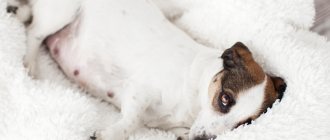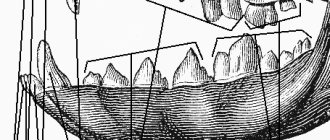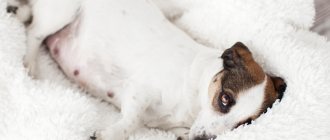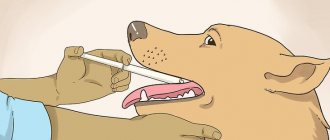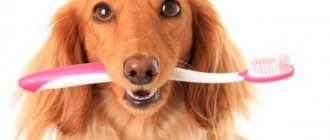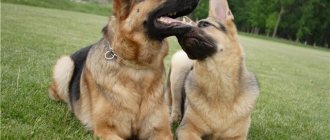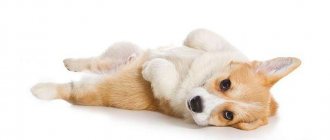Quite often in veterinary practice we encounter such a pathology as missing baby teeth in dogs.
The replacement of baby teeth with permanent ones occurs between the ages of three months and one year. This is a gradual process. First, the cutting incisors are replaced. They are followed by a change in the middle teeth and edges.
The first teeth to grow are the molars, following the premolars. This is due to the fact that there are no milk teeth in this place and nothing interferes with the growth of permanent teeth. The premolars are replaced next.
At the age of approximately 6-7 months, the canine teeth change. All other teeth are replaced gradually up to a year.
Milk teeth are considered not to have fallen out when a permanent tooth has just begun to emerge nearby, and it is not at all necessary for the permanent tooth to come out completely.
When do puppies start teething?
When introducing complementary foods, it is very important to note whether dogs have baby teeth. Until this moment, the pet is simply not able to chew solid food, so it is completely dependent on its mother.
The first snow-white teeth appear 20-25 days after birth and are fully grown by 1.5-2 months. The exact timing of eruption depends on the breed. In miniature dogs, this process is slightly delayed, occurring at 5-6 weeks of life.
Features of symptoms
The process of changing or losing teeth is accompanied by explicit or implicit symptoms. The clinical picture of the manifestation depends on the pet’s temperament.
Signs of age change include:
- restlessness, whining;
- partial or complete loss of appetite;
- temperature increase;
- gastrointestinal disorder;
- desire to chew objects;
- resistance to hygiene procedures.
Symptoms associated with oral diseases include:
- unpleasant odor from the mouth;
- redness and swelling of the gums;
- bleeding gums;
- excessive salivation;
- exposure of the root neck of the teeth;
- change in the shade of the mucous membrane to blue;
- change in the shade of bone tissue.
If there is a metabolic disorder, there is also a deterioration in the quality of the coat, impaired bone growth, weight loss, and the mouth begins to smell.
Bleeding gums is one of the signs of oral diseases
A little about the bite
After the milk teeth fall out, the four-legged pet grows 42 molars. Their position affects abrasion and wearability. With proper bite, a healthy dentition is preserved almost until old age.
Types of bites
The closure of the upper and lower jaws varies slightly between breeds. In such cases, the deviation from the norm is explained by genetics and is not a pathology.
There are 4 types of bite:
- Scissor-shaped
. The anatomical norm is when the upper incisors neatly cover the lower ones. When closing, the jaws do not touch, and a small gap of 3 mm is formed between them.
- Snack
. The lower jaw extends beyond the upper jaw, exposing the teeth located on it. This variety is typical for pugs, bulldogs and boxers.
- Pincer-shaped
. The jaws close in a straight line, so the incisors quickly wear down and become unusable.
- Underbite
. The gap formed during closure exceeds 3 mm. This violation is typical for a too shortened lower or elongated upper jaw. Due to the tight compression, the fangs wear down and break.
The last type is the most dangerous. Unlike a pincer bite, when overbiting, not only the incisors are erased, but the entire dentition.
Correct bite formula
With a correct bite, the animal should have exactly 42 teeth: 22 on the lower jaw and 20 on the upper. These include:
- 12 incisors;
- 4 fangs;
- 16 premolars;
- 10 molars.
Most breeds have a scissor bite. Misaligned jaws or a tongue protruding from a closed mouth is considered a pathology.
Reasons for chipping
What causes pieces of teeth to break off (what to do next depends on the provoking factors) most often:
- Traumatic effects on the dentition. This is possible due to a fight, a fall, or an accidental blow.
- Decreased immunity.
- Poor quality installation of orthodontic structures.
- Hormone imbalance. One of the prerequisites is diabetes mellitus and other endocrine diseases.
- Consumption of harmful foods. Caramel candies, nuts, and the simultaneous consumption of hot and cold foods lead to injury.
- Untreated dental pathologies.
- Incorrect positioning of incisors, canines and molars and nocturnal bruxism.
- Damage to caries. This applies to both the initial and later stages.
- Smoking and other bad habits. Alcohol and cigarettes contribute to the thinning of the enamel layer.
- Demineralization, lack of phosphorus, calcium and other essential substances.
- Low acidity in the mouth. An insufficiently balanced diet leads to an imbalance in the acid-base balance.
- Damage to the filling material.
- Presence of cracks on the surface.
- History of chronic diseases.
How many months do dogs change their teeth?
In most cases, the dissolution of milky roots occurs at the end of the 3rd or beginning of the 4th month. The entire “combat kit” appears by the first year of life. The exact time depends on the breed of the pet and some external factors.
Breed characteristics
Despite the general norm for the molar row, the number of teeth in the milk row of large and dwarf breeds differs from each other. The former grow only 28, while the latter grow 32. The remaining differences can be found in the example table.
| Breed | Age of complete change of dentition | Pain during teething | Possibility of complications |
| Large (Labrador, German Shepherd) | Up to 9 months | Low | Low |
| Dwarf (Spitz, Yorkshire Terrier) | Up to 11 months | High | High |
Knowing at what age dogs' teeth change, you can avoid possible complications. If the deviation from the norm is more than 2 weeks, be sure to contact your veterinarian.
External factors
In addition to breed characteristics, other factors are also important. The time at which a dog's teeth change depends on the climate, the quality of food and water consumed, and health status. Delayed appearance and frequent complications are typical for animals from cold regions that receive exclusively soft food and tap water that has not been pre-treated.
Restorative methods in dentistry
The method of restoration depends simultaneously on several factors: the degree of damage, the results of diagnostic studies, general health, medical history and financial capabilities of the patient. The therapeutic regimen is developed on an individual basis. What to do if a front tooth is chipped and why the back teeth are chipped should only be determined by a doctor; self-diagnosis is ineffective.
Remineralization
Remineralization therapy is the simplest recovery option for minor chips. The technique is used for microcracks and other small defects, as well as for preventive purposes to prevent such problems. A special solution with nutrients is applied to the surface, and as a result, the protective properties of the enamel are restored.
Fluoridation
Damaged and healthy teeth are covered with medicinal solutions, gels or varnishes with a large amount of fluoride. Treatment is carried out in stages. This is one of the effective ways to completely restore a chipped front tooth. This method is only beneficial for minor injuries.
Building up
Indicated for moderate injuries. A paste-like mass is applied to the surface in layers, each layer is fixed. The doctor must carefully select materials of the desired shade and texture so that the restored areas remain invisible and do not stand out from the rest.
This method is highly effective and attractively priced. The first thought that arises in most patients when asked what to do if a back tooth is chipped (chipped front teeth are rarely eliminated in this way) is to build up the missing fragment. The technique is in great demand.
Filling and microprosthetics
They are indicated for extensive damage to bone tissue and internal sensitive layers. The doctor carefully examines the results of diagnostic studies (including panoramic and spot images), listens to the patient’s complaints and advises which method is best to use. Restoration is possible using conventional fillings, inlays, veneers, and lumineers. What to do if a back tooth breaks off (the reasons do not matter) and is completely lost? In such a situation, prosthetics using implants or installation of artificial crowns is performed.
The amount that the patient sees in the final settlement after the intervention may be unpleasantly surprising. Before you ignore a small crack in the enamel and neglect a visit to the dentist, it is better to think about possible upcoming expenses.
The order and features of changing teeth in puppies
Teeth change in dogs occurs in a certain sequence. It is quite difficult not to notice this process, since it is accompanied by certain behavioral and physiological signs.
Sequence: from incisors to molars
A series of molars, canines, premolars and molars grow just inside the gums, putting pressure on the deciduous roots. Gradually they become thinner and fall out of the sockets, making way for permanent teeth. They appear in the following sequence:
- incisors – 3-4 months;
- fangs – 4-6 months;
- premolars – 6-7 months;
- molars – 5-8 months.
Molars erupt in several stages. The very first ones fix the dentition, contributing to the formation of a correct bite.
Behavioral and physiological signs of baby tooth loss
If the process is accompanied by pain, the pet may refuse to eat. Swollen gums return to normal within a couple of days after eruption. Your appetite should return on the second day. If this does not happen, it is better to take the baby to the veterinarian.
In the first days, the pet will constantly ask to be held or hide under a blanket. This is absolutely normal, since due to the changes occurring, his body temperature rises slightly (within 0.5 ° C).
You should only worry if the deviation from the norm persists for more than 2 days, and the puppy himself shows causeless aggression. These symptoms may indicate injury to the intestinal walls as a result of swallowing a lost tooth.
One of the most obvious signs is itching. The baby will chew everything he sees, and also scratch his face on the furniture or with his paws.
If any of the above symptoms appear, carefully look into your pet’s mouth. Slightly swollen and reddened gums, increased salivation and an unpleasant odor that persists for 1 month will help you recognize a new stage of growing up.
A little bleeding is acceptable immediately after prolapse. It stops on its own within 3 minutes.
What to do if the crown of a temporary tooth is broken?
If they removed temporary teeth and broke the crown, leaving the root in the gum with the words “it will resolve on its own,” I answer - no, it will not resolve.
Why should the root of a tooth dissolve because you have broken the crown? It will remain in the gums as a foreign body and at a certain time can cause the process of periodontitis of adjacent teeth or osteomyelitis of the jaw bones.
And one more thing - in no case should you “bite off”, “saw off” or break the crowns of temporary fangs if they “bite” into the gums or to “improve” the change of teeth. With any injury to the crown of a temporary canine, traumatic pulpitis occurs, and as a result, periodontitis develops with an abscess on the jaw, inside of which there is a rudiment of a permanent canine. Trauma, pain, inflammation and the possible loss of not only a temporary, but also a permanent canine - this is the price to pay for an incompetent attempt at self-medication.
In case of traumatic pulpitis of a temporary canine, the tooth must be immediately extracted (removed).
A broken tooth crown on the upper jaw of a dog. The tooth is subject to immediate extraction (removal).
Helping a puppy through a difficult period
When dogs change teeth, their immunity decreases. For the entire period, it is recommended to protect your pet from stress, intense physical activity, contact with other animals and vaccinations. You should also review your current diet, strengthen oral hygiene measures, and purchase teethers.
Gnawing accessories
A teether is a special device filled with water. Keep it in the refrigerator before use, as the low temperature reduces itching and inflammation. Using a teether, a regular rubber toy, or chewable treats can prevent damage to furniture and valuables.
Please note that it is better to remove dangerous objects away during this period. A baby suffering from itching may accidentally bite the wire and get an electric shock.
Oral hygiene
Regular oral hygiene protects against stomatitis, caries, tartar and other dental diseases. Your baby needs to be taught to brush his teeth to avoid problems in the future.
To clean the enamel, you need to purchase a special toothbrush, veterinary paste or cleaning gel. Move strictly from top to bottom from the outside of the jaw towards the inside.
The procedure should be repeated 5-10 times a month, and every 2 months the pet should be examined at a veterinary clinic. This way you can easily understand whether your dog has baby teeth, or whether the process of replacing them with molars has already come to an end.
Feeding
To form a beautiful and healthy bite, your puppy will need a lot of calcium and phosphorus. When feeding natural foods, be sure to include in your diet:
- veal;
- raw carrots;
- sea fish and fish oil;
- fermented milk products (cottage cheese, cheeses, kefir);
- beef liver;
- spongy bones and boiled cartilage;
- sea buckthorn oil.
The addition of ready-made vitamin and mineral complexes should be discussed with your veterinarian. Otherwise, you risk causing an overabundance of vitamins.
If your pet eats dry food, then it already contains all the necessary elements. All you have to do is focus on the baby’s well-being, combining granules and wet canned food. The former will help relieve itching, and the latter will help reduce the sensitivity of inflamed gums.
Dental care
Caring for your pet's oral cavity is one of the foundations of its health. To avoid dental diseases in your puppy, you need to carefully monitor his teeth. Carefully examine both baby and molar teeth for dirt, bite patterns, or uneven growth. A veterinarian will tell you how to brush your pet’s teeth at home. Also, consult with a specialist about what kind of paste and brush you should buy at a pet store, special for your puppy.
All problems are easier to prevent, so do not hesitate to contact your veterinarian in a timely manner.
Possible complications
Dwarf breeds have the hardest time with the change of baby teeth. If your pet is at risk, examine its oral cavity every day so as not to miss warning signs of complications.
Gum inflammation
Accompanied by redness and swelling of the mucous membranes, as well as profuse salivation, which worsens the appearance of the fur on the chest. This complication usually goes away on its own, but sometimes develops into periodontal disease. It can be identified by severe bleeding of the gums and a strong odor from the mouth.
Stuck teeth
Some animals retain 2 rows of teeth at once. This complication is called persistence. It is fraught with increased trauma to the mucous membranes and cheeks, as well as malocclusion.
Be sure to check if your dog has baby teeth next to his molars. If you find two shoots in one hole, contact your veterinarian. Sometimes the problem can be solved by manual loosening, but in most cases surgery cannot be avoided.
Malocclusion
Improper closing of the jaws is typical for breeds with an elongated muzzle: dachshunds, labradors, dobermans, rottweilers. It is facilitated by games of tug of war, feeding exclusively soft food and persistence.
To correct the bite, rubber corrector rings are used that act as braces. If the animal is not a show animal, then it is enough to prevent the situation from worsening and control the position of the jaws.
Malfunctions of the gastrointestinal tract
Quite often, babies experience diarrhea. It is not dangerous, as the stool quickly returns to normal. You should only worry if you experience symptoms of dehydration:
- dry mucous membranes, nose and coat;
- loss of activity and increasing lethargy;
- slow smoothing of skin crumpled into a fold by fingers.
Additionally, vomiting and fever may occur. A pet with such symptoms must be shown to a veterinarian within the first day after their discovery. Otherwise, he may die.
Special cases
Some injuries require a specific approach, which has its own characteristics against the backdrop of generally established rules. We should look at them in more detail.
Wisdom tooth
"Eights" cannot be restored. The fact is that this makes no sense, because they are not involved in the process of chewing food and are not so important for the functioning of the maxillofacial apparatus. Doctors resort to extraction; subsequent prosthetics are not performed.
Unit
Such damage is the most aesthetically unattractive, because it is visible to others if a person smiles or simply talks. Treatment methods can be any, it all depends on the dentist’s recommendations and the patient’s personal preferences and financial capabilities.
Most often, artistic restoration is used. The specialist selects the composition of the required shade and applies it to the surface. The layer of material is fixed with a special device with light radiation.
What to do if half a tooth breaks off, how will it be treated (a significant fragment has broken off along with dentin)? In this case, veneers are used. This is a reliable method that is durable. Over time, the color of the enamel does not change and remains attractive.
For the most serious damage, crowns made of ceramics, metal-ceramics, and zirconium oxide are installed. The final cost of therapy depends on the choice.
Lateral teeth
They are treated in the same way as the front ones. However, since others cannot see from the outside that there is anything wrong with your smile, ordinary fillings will do. The best option is extension. Overlays are not installed in this case.
If the nerve is damaged, the wound is first treated with an antiseptic. Then depulpation or extraction is carried out followed by prosthetics.
Dairy elements
What to do with a chipped tooth and how to treat it if it hurts? Many parents mistakenly believe that there is no need to correct problems that arise with children’s first incisors, canines and molars - they will fall out sooner or later anyway. This is a big misconception, because the doctor is able to quickly stop further cracking with a filling or a special gel without pain or other unpleasant sensations.
Children are often injured due to falls during active play. If you ignore the treatment of chips, this often leads to stomatitis and increased sensitivity of the dentition.
Procedure:
- calm the baby;
- give him clean water to rinse his mouth;
- disinfect soft tissues if they are damaged;
- save the fragment for the dentist.
No more than 24 hours should pass from the moment of injury to the visit to the dentist. Most likely, the child will be sent for an X-ray. The condition of the permanent one depends on the health of the primary occlusion.
Vertical crack
What should you do if your front tooth chips a little, but the absence of fragments is not visible, only a crack running from top to bottom is noticeable? At first glance, this problem seems insignificant. However, this opinion is erroneous, because most often the pulp is involved. In this case, the enamel layer cannot be restored.
If at first only a small strip is visible on the surface, over time, under constant pressure, it develops into large chips. Timely consultation with a doctor guarantees quick and easy restoration of the dental unit. Otherwise, you cannot do without installing crowns or veneers.
Procedure for tooth loss
If your puppy has lost a baby tooth, then nothing needs to be done. This is a natural phenomenon that does not harm the dog’s health.
In other situations, the oral cavity should be examined. If a dog’s tooth has fallen out over time, the hole should be treated with chamomile or saline solution. If redness, bleeding or enamel fragments are detected, you should contact a veterinarian dentist. He will sanitize the mouth. He will suggest doing diagnostics to identify the cause of the problem. Prescribe treatment.
Treatment for tooth loss is aimed at stopping the process and strengthening bone tissue. It includes a therapeutic regimen, changing the diet to a suitable one.
Important! Teeth with deep caries in dogs cannot be treated. The source of pain is completely removed.
Malocclusion is a common problem caused by untimely tooth loss.


